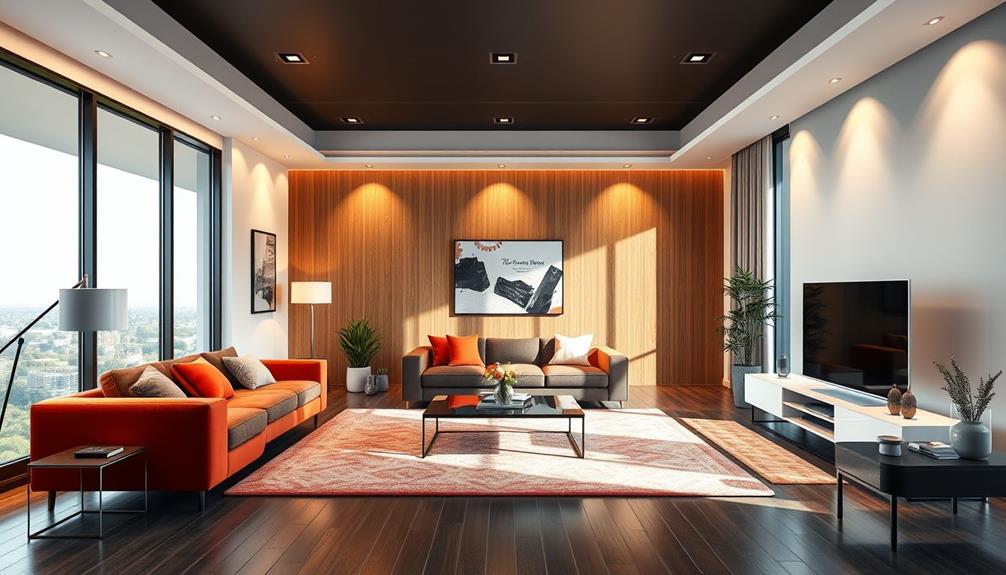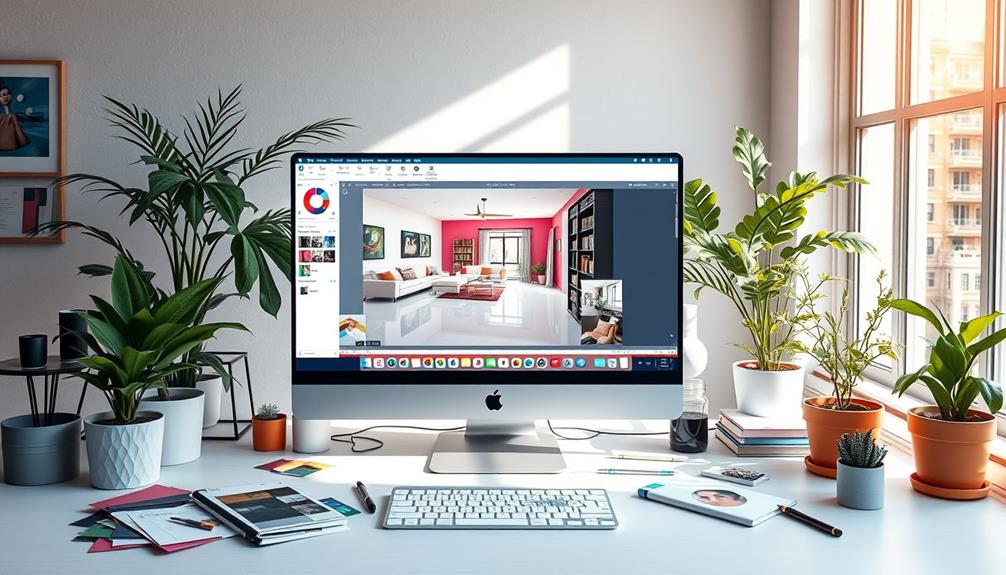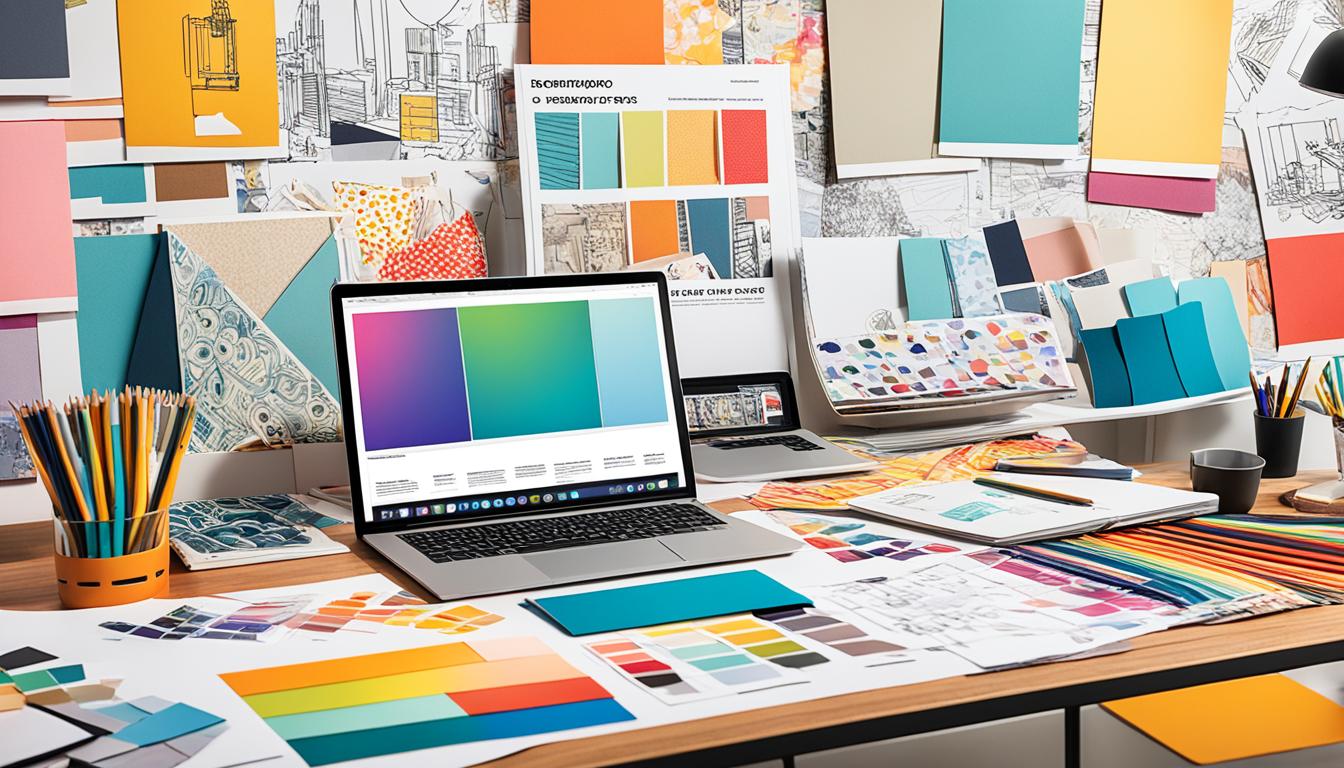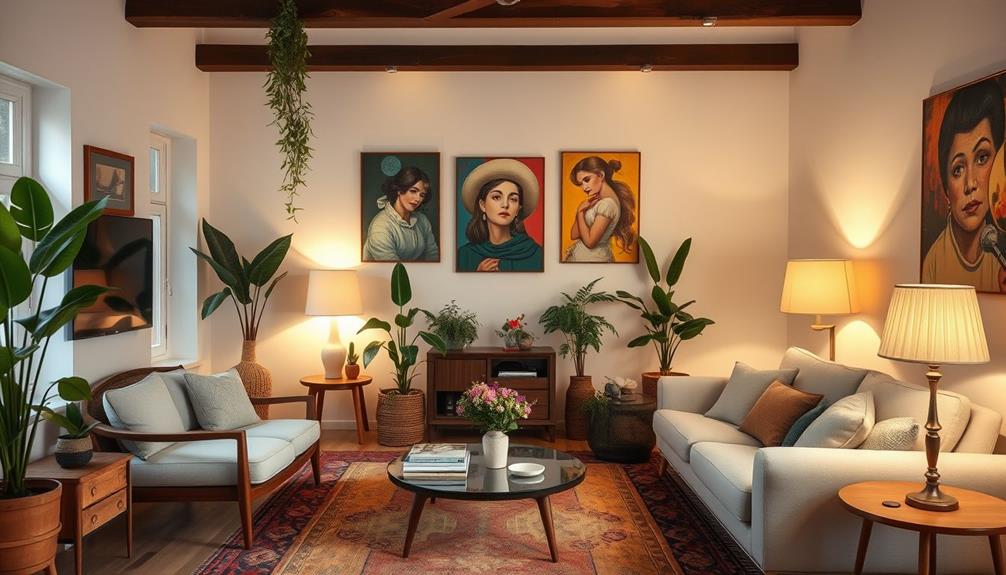To get into interior designing, start by pursuing a relevant degree, like a bachelor's in interior design, which takes about four years. You'll need hands-on experience, so seek internships or entry-level positions to build your skills. Familiarize yourself with essential design software like AutoCAD and hone your communication abilities. Obtaining certification, such as passing the NCIDQ exam, is vital for professionalism. Networking through professional associations and industry events will enhance your connections and opportunities. Staying updated on trends through publications and online resources will also keep your designs fresh. There's more to explore to help you succeed in this exciting field! Consider participating in workshops and continuing education courses to further develop your skills and stay current with industry practices. Research and explore different interior design degree programs to find the best fit for your career goals and interests. Additionally, consider joining a mentorship program or finding a mentor in the field to provide guidance and support as you navigate your career in interior design. Always be open to learning and growing as a professional in this dynamic and creative industry.
Key Takeaways
- Obtain a relevant degree in interior design, ideally accredited by the Council for Interior Design Accreditation (CIDA), to enhance career prospects.
- Gain practical experience through internships, entry-level positions, and personal projects to build skills and a professional portfolio.
- Develop software proficiency in design tools like AutoCAD and SketchUp, and enhance communication skills for effective client interactions.
- Prepare for and pass the NCIDQ exam, which is essential for certification and often required for state licensing.
- Stay updated on industry trends through publications, blogs, and networking events to remain competitive in the field.
Understanding Interior Design

Interior design is more than just decorating; it's a professional discipline aimed at enhancing indoor spaces through thoughtful planning and design. As you explore interior design, you'll discover it involves a deep understanding of design principles and the ability to apply them effectively.
Unlike decorators, interior designers engage in extensive project management, including space planning, budgeting, and ensuring compliance with building codes.
Whether you're interested in residential interior or commercial interior design, each sector demands a unique approach tailored to client needs. You'll need to harness your creativity to develop innovative solutions that enhance both functionality and aesthetics.
Additionally, successful designers excel in problem-solving and communication skills, enabling them to collaborate with clients and architects seamlessly.
Professional development is essential in this field, as staying updated on industry trends, materials, and techniques can set you apart.
Educational Pathways

When starting your journey into interior design, choosing the right educational pathway is crucial. A bachelor's degree in interior design typically requires four years of study, covering essential subjects like design theory, color theory, and computer-aided design (CAD) software. This thorough education prepares you for various challenges in the field.
If you're looking for a quicker route, an associate degree offers a two-year path that equips you with foundational skills necessary for further education in interior design.
To guarantee your program meets industry standards, seek out institutions with accreditation from the Council for Interior Design Accreditation (CIDA). This accreditation not only assures quality education but also enhances your job placement prospects.
After earning your degree, you may need to meet work experience requirements to qualify for the National Council for Interior Design Qualification (NCIDQ) exam, which is necessary for certification in many states.
Lastly, remember that continuing education and workshops are crucial in keeping your skills sharp and staying updated on the latest industry trends and technologies. Embrace these educational pathways to set yourself up for a successful career in interior design.
Skills Development
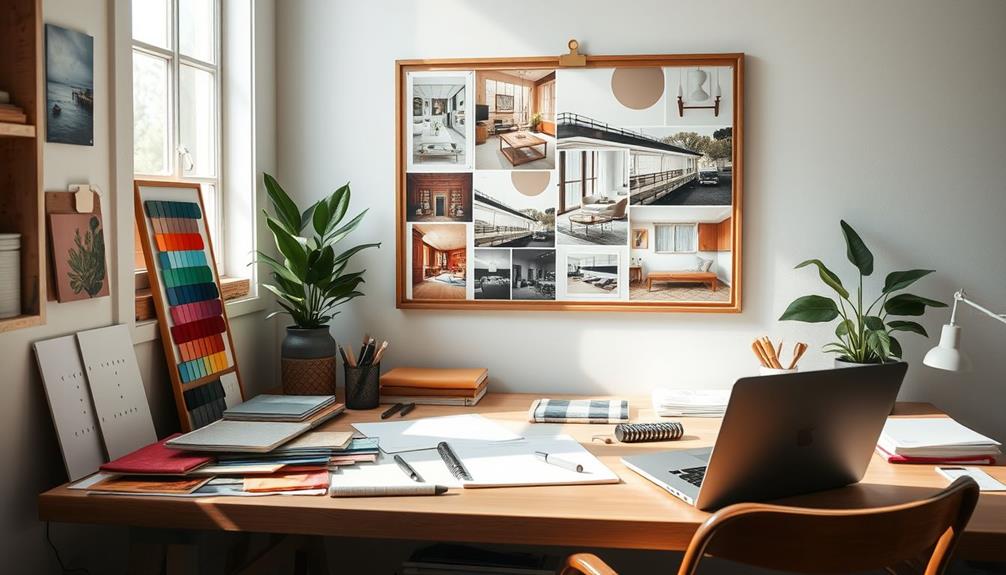
After laying a solid educational foundation, honing specific skills is indispensable for success in interior design. Your creativity and artistic ability are imperative for developing innovative design concepts that resonate with clients and elevate spaces.
Additionally, understanding the emotional landscape of clients can enhance your designs and cater to their personal tastes, as seen in the exploration of astrological compatibility and its effects on attraction. You'll also need proficiency in design software like AutoCAD, SketchUp, and Revit to create accurate and professional design plans.
Strong communication skills are essential, too. They'll help you interact effectively with clients, understand their needs, and present your design ideas clearly.
Attention to detail is another key skill; ensuring high-quality execution of designs—from selecting materials to finalizing layouts—depends on this.
Time management skills are equally important as you'll often juggle multiple projects while meeting tight deadlines. Balancing these various demands is part of what makes a successful interior designer.
As you develop these skills, remember to build a professional portfolio showcasing your best work. This portfolio will be indispensable when you seek job opportunities after earning your interior design degree.
Focus on refining these skills, and you'll set yourself up for a successful career in the dynamic world of interior design.
Gaining Practical Experience
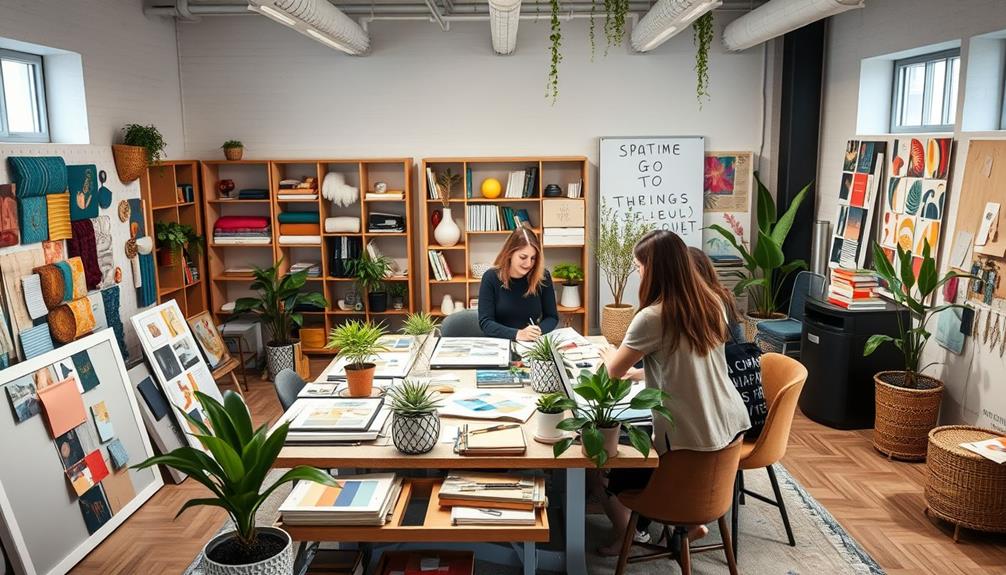
How can you effectively bridge the gap between theory and practice in interior design? Gaining practical experience is essential for building your interior design career. Here are some effective ways to gain experience:
- Internships: Seek internships at design firms to get hands-on experience and insights into the design process.
- Entry-level positions: Look for roles like Interior Design Assistant or Junior Designer, where you'll work under seasoned professionals.
- Community projects: Volunteer for non-profit organizations, which helps build practical skills while enhancing your portfolio.
- Personal projects: Redesign spaces in your home or help friends and family with their projects to practice your design skills.
- Design competitions: Participate in competitions to tackle real-world design challenges and increase your visibility in the field.
Certification and Licensing

To launch your career in interior design, you'll need to understand the educational requirements and licensing regulations that apply in your state.
Passing the NCIDQ exam is a key step, as it evaluates your skills and knowledge in essential areas of the profession.
Familiarizing yourself with local laws and continuing education requirements will guarantee you stay compliant and competitive in the field.
Educational Requirements Overview
For those aspiring to enter the field of interior design, understanding the educational requirements is indispensable. Most design professionals need a bachelor's degree in interior design or a related field to practice. These programs often cover essential topics such as architecture, color theory, and space planning.
Additionally, certification from the National Council for Interior Design Qualification (NCIDQ) is significant, especially since many states require it for licensure.
Here are some key points to examine regarding educational requirements:
- A bachelor's degree in interior design from an accredited institution is typically mandatory.
- Certification from the NCIDQ involves passing a three-part exam and meeting specific educational and work experience criteria.
- Some states enforce title acts or licensure requirements, making the NCIDQ exam imperative for legal practice.
- Continuing education units (CEUs) may be necessary to maintain certification and keep up with industry trends.
- Joining professional organizations like the American Society of Interior Designers (ASID) can provide valuable resources and networking opportunities.
NCIDQ Exam Essentials
Charting the path to certification through the NCIDQ exam is essential for aspiring interior designers. To be eligible, you typically need a degree in interior design or a related field, along with 2 to 4 years of supervised professional experience. This combination guarantees you have the foundational knowledge and practical skills necessary to excel in the field.
The NCIDQ exam consists of three parts: the Interior Design Fundamentals Exam (IDFX), the Interior Design Professional Exam (IDPX), and the Practicum Exam. Together, these assessments evaluate your understanding of design principles, project management, and professional practice.
Passing the NCIDQ exam not only earns you an interior design qualification but is often a prerequisite for obtaining a state license to practice as an interior designer.
Furthermore, holding an NCIDQ certification greatly boosts your professional credibility, making you more competitive in the job market.
State Licensing Regulations
Understanding state licensing regulations is essential for anyone looking to practice interior design professionally. Many states require you to become a licensed interior designer, which often involves passing the NCIDQ exam. This exam consists of three parts: IDFX, IDPX, and Practicum.
Each state has distinct requirements, which can include:
- A degree from an accredited program
- A specified number of supervised work experience hours
- Passing the NCIDQ exam
- Completing continuing education units (CEUs) to maintain licensure
- Obtaining professional certification from organizations like ASID or IIDA
States like California and New York enforce strict licensing regulations, while others may have more lenient requirements or none at all. This means you'll need to research the specific regulations in your state.
Additionally, pursuing a professional certification can enhance your credibility and expand networking opportunities, making it easier to connect with potential clients and employers. Staying current with continuing education units is also essential, ensuring you remain updated on industry standards and practices.
Networking and Professional Growth

Networking and professional growth are essential in the interior design field, where many job opportunities arise from personal connections rather than traditional job postings.
To build a strong network, consider joining professional associations like the American Society of Interior Designers (ASID) or the International Interior Design Association (IIDA). These organizations provide access to valuable industry resources and mentorship opportunities that can guide your career.
Attending design events, trade shows, and workshops is another excellent way to enhance your visibility and connect with potential clients and collaborators.
These gatherings often lead to referrals, which can greatly impact your job prospects.
Don't underestimate the power of online platforms like LinkedIn and design-focused social media such as Instagram and Pinterest.
Staying Current With Trends
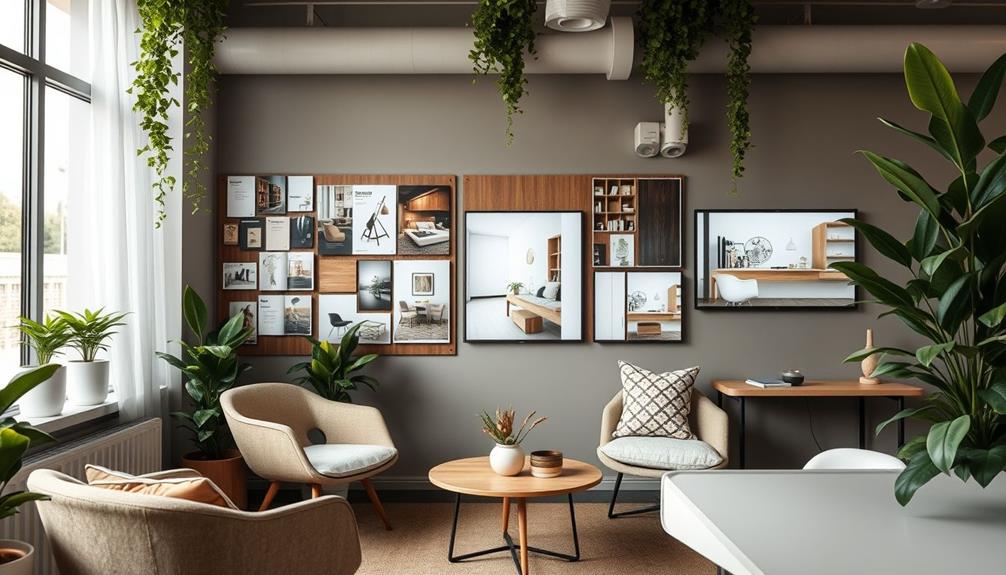
To stay current with interior design trends, you need to actively engage with industry publications and blogs that highlight the latest innovations.
Taking advantage of continuing education opportunities will also keep your skills sharp and relevant.
Additionally, attending networking events can connect you with fellow designers and expose you to emerging ideas in the field.
Industry Publications and Blogs
Staying updated with the latest trends in interior design is essential for anyone looking to make their mark in the industry. One of the best ways to do this is by immersing yourself in industry publications and blogs that provide valuable insights and inspiration.
Here are some key resources you should consider:
- Industry Publications: Subscribe to magazines like *Interior Design* and *Architectural Digest* for insights on design trends and innovative materials.
- Design Blogs: Follow blogs like *Design*Sponge* and *Apartment Therapy* for practical tips and creative ideas for your projects.
- Online Platforms: Explore Houzz and Pinterest to discover diverse styles and connect with a global community of design enthusiasts.
- Professional Associations: Engage with organizations like the American Society of Interior Designers (ASID) for updates on industry standards and best practices.
- Research Journals: Regularly read the *Journal of Interior Design* to familiarize yourself with scholarly research, case studies, and advancements in design theory.
Continuing Education Opportunities
In the fast-paced world of interior design, keeping up with trends is essential for your success and professional growth. To do this effectively, you'll need to focus on continuing education units (CEUs). Many states require 10-20 hours of education every two years to fulfill licensing requirements, ensuring you stay updated on important changes in the field.
By embracing a culture of continuous improvement through these educational opportunities, you can further enhance your skill set and adaptability in an evolving industry.
Organizations like ASID and IIDA provide valuable workshops, seminars, and online courses that explore the latest design techniques and sustainable practices, enhancing your professional knowledge.
Online platforms such as Coursera and Skillshare offer flexible courses on topics like color theory and CAD software, allowing you to learn at your own pace.
Additionally, attending industry events, trade shows, and conferences is a great way to discover new products and innovative design software directly from manufacturers and thought leaders.
Subscribing to design journals, magazines, and blogs can also help you stay informed about emerging styles and cutting-edge materials.
Embracing these continuing education opportunities not only sharpens your skills but also positions you as a knowledgeable designer in a competitive marketplace.
Networking and Events
Continuing education not only sharpens your skills but also opens doors to valuable networking opportunities. Engaging with industry events, like trade shows and design expos, lets you connect with potential clients and peers while keeping you updated on emerging trends.
For instance, exploring Island Getaways could inspire unique design themes in your projects. Here are some effective ways to enhance your networking and stay current:
- Join professional organizations like ASID or IIDA for exclusive access to workshops and networking events.
- Attend local design meetups to build relationships with other designers and industry professionals.
- Participate in community workshops to enhance your knowledge of current design movements and market demands.
- Leverage online platforms such as LinkedIn and Instagram to follow industry leaders and share your work.
- Engage in design-focused forums to discuss innovations and trends with fellow designers.
Conclusion
As you step into the vibrant world of interior design, remember it's not just about spaces; it's about crafting dreams. With each color you choose and every fabric you select, you're painting stories that breathe life into homes. Embrace the journey of learning, connecting, and evolving. Your passion will be the brush that transforms blank canvases into masterpieces. So, immerse yourself, let your creativity soar, and watch as you turn visions into reality, one room at a time.

